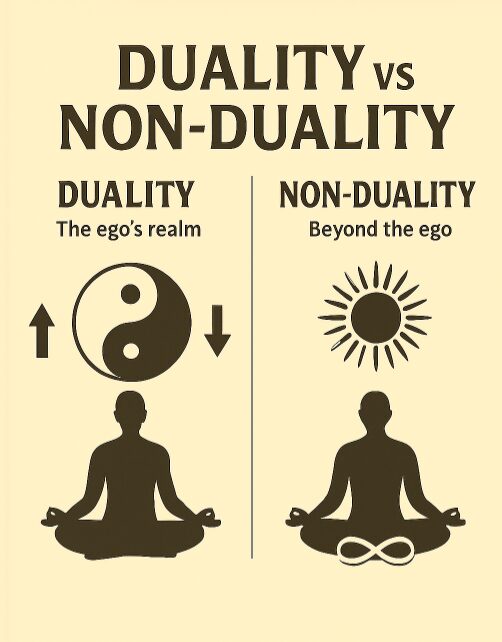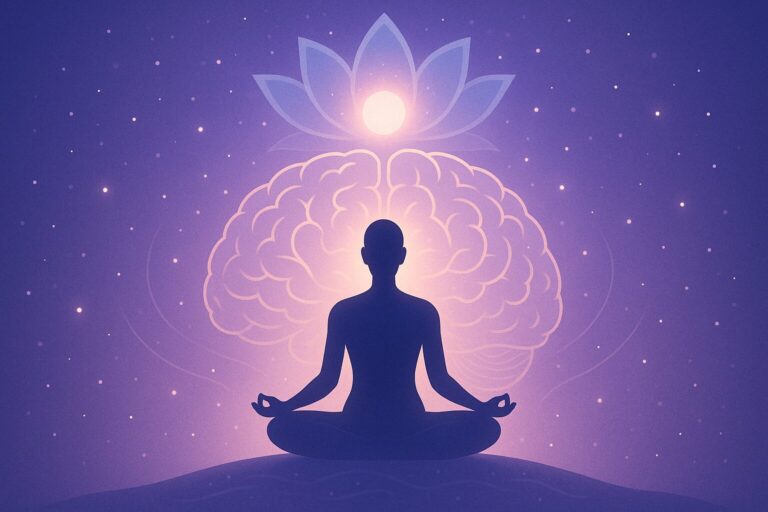Duality vs. Non-Duality: A Spiritual Perspective and Their Role in Our Lives
Life can often feel like an intricate dance of opposites: light and dark, joy and sorrow, success and failure, gain and loss. These constant contrasts are what many spiritual traditions call duality, the experience of life as a series of opposing forces. On the other hand, there is a deeper spiritual understanding known as non-duality, which goes beyond these surface-level differences and reveals the underlying unity of everything. By exploring these two perspectives, we gain valuable insights into our own nature and the world around us. This understanding becomes a powerful guide for personal growth, spiritual awakening, and finding lasting inner peace.

What is Duality?
Duality is the perception of the world through distinctions and opposites. It is the lens through which the human mind naturally interprets experiences. In this state, we see ourselves as separate individuals navigating a world of other separate entities.
Examples of duality:
- Good vs. Evil
- Life vs. Death
- Love vs. Hate
- Self vs. Other
- Profit vs Gain
In many spiritual traditions, duality is considered the realm of the ego. The ego thrives on separation, defining identity through contrasts like “me” and “you,” “mine” and “yours.” This sense of separation helps us function in the physical world by creating boundaries and categories. Without duality, we would lack the ability to differentiate between safe and dangerous situations or discern right from wrong decisions. It is duality that enables us to set goals, form relationships, and protect ourselves.
However, when we live only through the lens of duality, we become trapped in endless cycles of conflict, attachment, and suffering. Duality fuels comparison and competition, leading to feelings of superiority or inferiority, craving or aversion. For example, when we cling to pleasure and resist pain, we try to seek pleasure most of the times whenever possible. It can be in the form of a nice movie, sex or a tasty food. This also makes us lazy and lethargic and tend us to get things done in shortest or easiest ways. Without the pain of efforts, persistence and discipline it becomes difficult to achieve our goals leading to frustrations and we create internal turmoil. This is just because we think of pain and pleasure as separate entities. Similarly when we see others as entirely separate from ourselves, we may fall into judgment, anger, or fear.
Spiritual significance of duality:
Duality is not inherently bad. In fact, it plays a vital role in spiritual evolution. It acts as a classroom for the soul, presenting us with challenges and contrasts that promote growth. By experiencing joy and sorrow, we develop empathy. By facing conflict, we learn forgiveness and patience. Each polarity in life serves as a mirror, reflecting lessons we need to integrate. In this way, duality provides the necessary framework for cultivating virtues like compassion, wisdom, and humility.
Ultimately, duality is a stepping stone. It gives us the raw material of life experience, which, when understood deeply, points us toward the greater truth of non-duality.
What is Non-Duality?
Non-duality, or Advaita in Sanskrit, literally means “not two.” It is a spiritual understanding that beyond the play of opposites lies a unified reality. Non-duality teaches that everything is interconnected and ultimately one.
In non-dual awareness:
- No separation between self and the universe: The boundaries we perceive between “me” and the world dissolve. We begin to see that the same life force that flows through our body and mind also flows through all of existence. We stop seeing ourselves as separate and instead understand that we are all part of something bigger, just like each wave is part of the same ocean.
- Good and evil dissolve into a larger understanding: From the dualistic perspective, we judge actions and experiences as right or wrong, good or bad. In non-dual awareness, these judgments soften as we see that all events arise from the same source. Rather than labelling things as purely negative or positive, we understand them as necessary movements within the grand tapestry of life.
- The observer and the observed merge: Normally, we experience ourselves as separate observers looking out at the world. In non-dual realization, this separation collapses. There is only pure awareness, a seamless flow of experience where the “seer” and the “seen” are one. Life is no longer divided into subject and object but experienced as a unified, dynamic whole.
Many mystical traditions across the world speak of non-duality, including Advaita Vedanta, Buddhism, Taoism, Sufism, and Christian mysticism. Enlightened teachers such as Ramana Maharshi, Lao Tzu and others have all pointed to this realization in their teachings.
Benefits of realizing non-duality:
- Profound inner peace and freedom from suffering: When we no longer see ourselves as separate from life, our inner conflicts quiet down. This brings a deep calmness and a release from the constant push and pull of desire and aversion.
- Dissolution of fear: Fear often comes from trying to protect a fragile sense of self. In non-dual awareness, we realize there is no separate self to defend. This understanding naturally dissolves many of our anxieties and insecurities.
- A deep sense of love and unity with all beings: Recognizing our shared essence with all life fosters unconditional love and compassion. This love isn’t based on personal attachment but flows freely, creating a feeling of connection and belonging with everyone and everything.
Duality vs. Non-Duality: The Relationship
At first glance, duality and non-duality seem like opposites. However, they are deeply interconnected. Non-duality does not reject duality; instead, it sees duality as a temporary appearance within the one unified reality.
Analogy: Think of the ocean and its waves. Duality is like the waves, each appearing separate and distinct. Non-duality is the ocean itself, the source from which all waves arise and into which they return.
A spiritually mature perspective recognizes both levels:
- Relative truth: In daily life, duality is practical and necessary. We must make choices, follow moral guidelines, and interact as individuals.
- Absolute truth: At the deepest level, everything is interconnected and ultimately one.
Why This Matters in Daily Life
Understanding and integrating both duality and non-duality can profoundly transform our lives:
- Reduces suffering: When we realize that pain and joy are two sides of the same coin, we become less reactive and more resilient.
- Fosters compassion: Seeing others as extensions of ourselves naturally leads to empathy and kindness.
- Brings clarity: Duality helps us navigate the world effectively, while non-duality prevents us from being overly attached to outcomes.
- Supports spiritual growth: Balancing both perspectives allows us to live in harmony with the world while awakening to our true nature.
Practical Ways to Experience Non-Duality
While non-duality is ultimately a direct realization beyond words, there are practices that can open the door to this experience:
- Meditation: Observing thoughts and sensations without identification gradually reveals the underlying awareness.
- Mindfulness: Staying fully present helps dissolve the illusion of separation.
- Self-inquiry: Asking questions like “Who am I?” can point to the non-dual nature of the self.
- Contemplation of nature: Witnessing the interconnectedness of life can evoke a sense of unity.
- Service and compassion: Acts of selfless love help dissolve the ego’s boundaries.
Conclusion
Duality and non-duality are not mutually exclusive; they are two aspects of the same spiritual journey. Duality gives us the playground of life where we can grow, learn, and evolve. Non-duality offers the ultimate liberation by revealing that all distinctions are part of a greater whole. By understanding and harmonizing these perspectives, we can live with greater peace, wisdom, and love, embracing life fully while awakening to the timeless truth of oneness.

